Still some finishing touches to the new CKHH website but the Medieval Canterbury Weekend 2024 details are all on it which means I’m still very hopeful that the website can be launched next week.
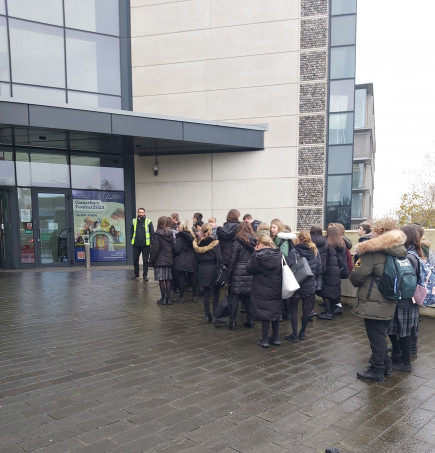
For the blog this week, I had hoped to feature Maureen’s presentation to the Kent History Postgraduates group but unfortunately Maureen was not well today, which means that it has been postponed until next month. However, some of the postgraduates still met up in Augustine House for a pre-Christmas social and thus enjoyed lunch together. Obviously, everyone wished Maureen a speedy recovery and we can all find out about how in the 17th century the Tonbridge deer parks and chases were broken up to form an agrarian landscape next time.
Consequently, I’ll now turn to my second topic for this week, the absolute final event for Dr Diane Heath’s ‘Medieval Animals Heritage’ project, this week also seeing the final MAH project board meeting before the end of project report is sent to the National Lottery. For Diane’s final event, this was the postponed visit by Year 8 students from the Royal Harbour Academy in Ramsgate to Canterbury to explore a number of locations, including Canterbury Cathedral, the CCCU Augustine House library, buildings on the main university campus and, of course, the two ‘Green Dragons’ in Becket Garden, using the theme of ‘medieval animals’ in a wide range of ways. To do this, I’ll be quoting from Diane’s report about the day and bringing you some of her photos as well as those from Michelle Crowther.

“The RHA pupils began their day with CCCU with a tour of Canterbury Cathedral with Dr Heath. They visited Becket’s shrine, the Chapter House, the cloisters, and the nave to explore some of the history and heritage of Canterbury.” Having learnt about some of the details concerning Becket and his early cult, “we saw the place where St Thomas Becket died in the Cathedral.” Moreover, later that day “Dr Catriona Cooper told us more about the medieval stone carving of Becket coming back from exile.”
The focus on medieval pilgrims and other visitors who came to Becket’s shrine was followed up by looking for images and sculptures of animals in the Cathedral. “In two 12th Century Miracle stained-glass windows, we saw a pilgrim riding a white horse to Canterbury. In another we saw Adam the Forester attacked by poachers who has just killed an animal (Adam survived and he thought it was a miracle). We spotted creatures on wooden seats in the Cathedral and carved on the Christ Church Gate.”
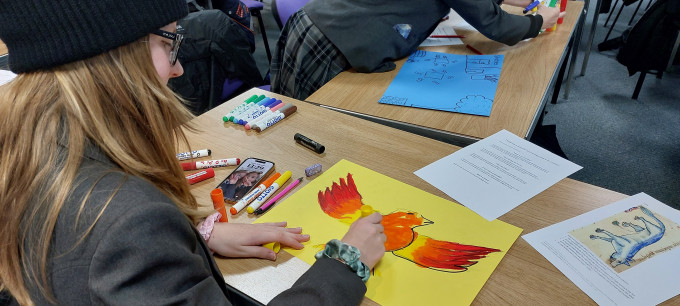
The next stop was Augustine House and the library workshops. There the pupils learnt 5 key ideas: “Animals are living organisms that feed on organic matter, usually they have sense organs and nervous systems and can respond rapidly to stimuli.” The second is: “Medieval animals include all the animals we know today and all the ones we wish still existed, like dragons, unicorns, centaurs and mermaids…” which brings us to the third: “Heritage includes features that belong to the past culture of a particular society, e.g., language, customs and architecture and are still valued. Green heritage relates to creatures and plants associated with specific heritage sites.” The fourth is “Severe problems caused by changes in the weather such as warming caused by humans polluting the atmosphere with greenhouse gases like carbon dioxide.” The fifth being: “Mitigating climate change means cutting greenhouse gases from main sources such as power plants, factories, cars, and farms. Forests, oceans, and soil absorb and store these gases, and are an important part of the solution. Sustainability is about meeting the world’s needs now and in the future by creating systems so we can live well and within the limits of our planet.”

Having heard about these, the “RHA pupils enjoyed a tour of the Library led by Michelle Crowther, key librarians and Harry from the Student Green Office. The pupils learnt about the award-winning building’s sustainability, including using the natural stable temperature in the earth, with 258 structural piles as geo-thermal energy sources, that provide 20%+ of the building’s energy. Carbon emissions have been reduced by 23%.” Then it was time for the workshops, the group split into two: the ‘Dragons’ and the ‘Unicorns’ so that while one group had their tour of the building, followed by an “eco-warrior badge making activity” the other group took on “Task 2: Design a colourful eco-heritage space for children (be creative – think mountain lair, forest den, cliff eyrie, crystal cavern, fabulous treehouse) on A3 coloured card using felt tips and paint sticks.”
“The badge-making activity took place in our Library’s Atrium Social Learning space. This airy space is also part of our CCCU students’ wellbeing space #StressLess. Harry joined us. He is a CCCU student and Project Officer from the Student Green Office and helped build our climate emergency dragon in CCCU Becket Gardens.” For Task 2, “Creative and imaginative art centring on eco-heritage, wellbeing and sustainability, included an image of a Phoenix that represents regeneration.” For this, “Bob, our CCCU librarian focussing on education, prepared a hints and tips sheet. Dr Heath prepared some Medieval Animals info sheets.”
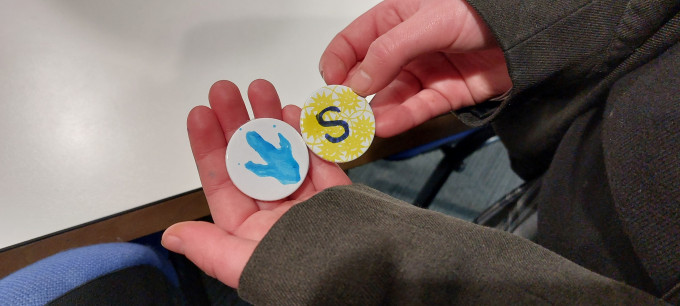
Then it was off to the main campus for the “Sustainability Tour with John Hills, Sustainability Projects Officer and Jack, CCCU student and Student Green Office project officer.” Under the banner “Green Heritage and Sustainability” it is great that “Our campus holds a unique space in Canterbury’s history. We sit in the outer precinct of St Augustine’s Abbey, an ancient monastery that is a key element of Canterbury’s UNESCO World Heritage site, which includes the Cathedral and St Martin’s Church.” To reflect this “John Hills and Jack from the Student Green Office guided RHA pupils and staff to the vineyard outside Verena Holmes Building. Then, via the hop poles near Fisher Tower, we walked to Becket Gardens where green heritage and sustainability meet in the shape of our two student and volunteer-built dragons, Spiro and Baby. This was a fun project with a serious theme of climate mitigation.”
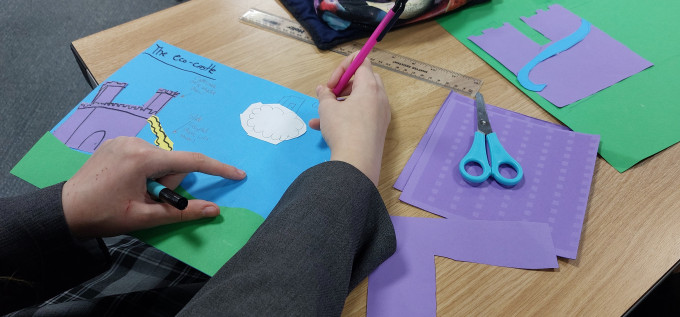
To get a taste of what it means to be a university student, the next stop was the Verena Holmes building for mini lectures. “Our newest building, Verena Holmes, places engineers, scientists, doctors, and healthcare students together in an inspirational learning environment, with industry standard, hi-tech facilities throughout. Dr Cat Cooper gave a mini lecture on the V&A St Thomas Becket medieval stone altar fragment (the size of a paving slab) re-envisioned with 3D printing technology for handheld tactile engagement.”
The second mini lecture was by Diane: “We looked at a 1,000-year-old book that was once in Canterbury Cathedral’s medieval library and owned by St Dunstan. The manuscript has an ‘animal list’ in Latin added to the first leaf. We learnt how these funny animal sounds were linked to memory – forging the equivalent of Sherlock Holmes’s fuzzy logic palace! Then we noticed that some sounds we associate with animals come from Latin words; ‘Ovis balat’ means ‘the sheep bleats’.”
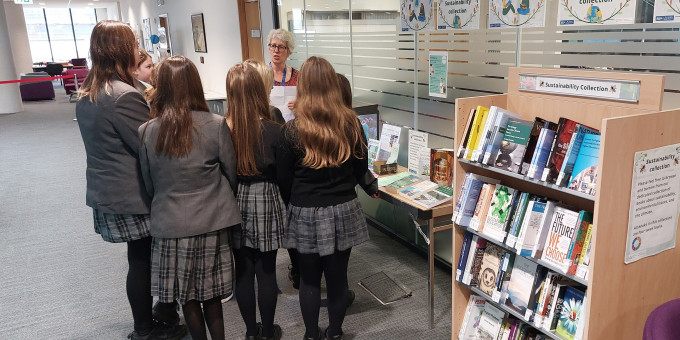
Thus, through all these activities the pupils discovered that “Heritage is not just about what we can see and read but about what we can understand through touching and hearing too.” And as a final comment “All of us at CCCU wish RHA staff and Year 8 the very best. Thank you for joining us today – you are fantastic.”
 Centre for Kent History and Heritage
Centre for Kent History and Heritage Sheila Sweetinburgh
Sheila Sweetinburgh 1033
1033

